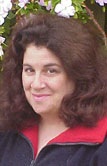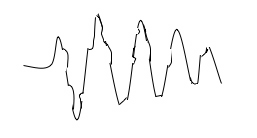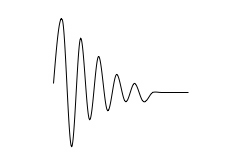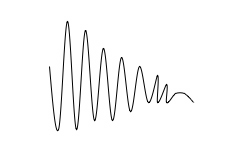December 2005 Article Tennis Server
|

 |
A few readers have suggested that some information be provided on vibration dampening. So that we all have the same knowledge, this column will start with a discussion of racquet stiffness and flexibility, the difference between vibration and shock, and vibration of the different parts of the racquet. Next month this column will continue with vibration dampening. Today's racquets are intentionally designed to be stiff. Simply put, stiff racquets bend less than flexible racquets and that stiffness reduces the frame's vibration. For balls hit near the middle of the racquet this has little consequence, but for balls hit near the tip of the racquet the reduced vibration provides more power (and ball speed). In addition, less vibration "feels" better and is more comfortable. When a racquet is bent or flexed, it will attempt to restore itself to its original shape. However, typically it will overshoot that original neutral (unbent) position in the opposite direction, and then rapidly move back and forth, back and forth with smaller and smaller deviations until the original unbent position is restored. This back and forth fluctuating motion is the vibration. When vibration is quantified or we want to determine "how much" vibration there is, we look at the vibration's frequency and amplitude. Racquet vibration frequency is measured in hertz (Hz). One hertz is equal to one cycle a second. The stiffer the racquet is, the higher the frequency for a given system state. A flexible racquet may vibrate at about 140 Hz and a stiff one at 200 Hz. As a point of reference strings vibrate at about 500 Hz. Different racquets, of course, use different materials, vary in frame and material thickness and geometry design. Subsequently, different parts of racquets vibrate at different frequencies. Shock Versus Vibration Shock is the jolting, jarring sudden impact. It is the single pulse event, created as the ball impacts the racquet. Vibration is the rapid fluctuation - the continuous periodic motion alternating in opposite directions from the object's equilibrium (original) position. When two objects collide (like a racquet and ball) the objects exert forces in equal and opposite directions. In tennis, this is clearly seen as the ball hits the racquet and it rebounds off. However, the racquet's "equal and opposite" motion is not as obvious, because your hand is holding onto the racquet. The racquet pushes against your finger and hands, rotating your wrist slightly and transmitting the shock to your arm. Shock (and minimizing shock) is related to one of the three sweet spots on a racquet - the center of percussion. Suspend a racquet, tying a string approximately where your index finger would grasp the racquet. The racquet can still move freely. When a ball strikes the racquet, the racquet can move in the translational direction (the direction the ball was moving before it struck the racquet) and can rotate (in the direction the ball rebounds off the racquet). The result is that the handle swings, exerting a force on your hand. However, when a ball strikes the center of percussion, those translational and rotational forces cancel each other out. Your hand does not feel the impact. Sweet Spot - The Node of the First Harmonic Vibration is related to a different sweet spot, "the node of the first harmonic," called "the node." This is the point of minimum vibration felt by your hand and arm. There is an area which forms a curved line from about the 2 o'clock to the 10 o'clock position on the racquet. If the ball strikes anywhere on the line the racquet does not vibrate. The sweet "spot" is the intersection of this curved line with the long axis of the racquet. If you hit the sweet spot, the racquet will not vibrate nor will it rotate and twist in your hand. If you hit the ball on the curved node line the racquet will not vibrate but it will rotate. Racquets can actually vibrate in a variety of ways and hence can have a different frequency of vibration. If the racquet was clamped at the handle, the motion of the tip of the racquet would look more like the oscillation of a diving spring board. The vibration would have a lower frequency - perhaps 20-30 Hz (20-30 cycles per second). However, our hand isn't as rigid as a clamp. Consequently, the racquet vibrates at both ends and in the range of 100-200 Hz. The diagrams in Figure 1 depict the oscilloscope patterns of racquet with the handle clamped. The oscillation pattern in Figure 1.1 represents the racquet when the ball hits the node (the sweet spot). Figure 1.2 represents a ball hit above the node near the tip of the racquet. (The pattern for a ball that hits near the throat of the racquet looks similar to Figure 1.2.) Note the difference between Figure 1.1 and the other figure. In Figure 1.1 the wave pattern is smooth - the ball hit the sweet spot. In the second pattern you see the additional disturbances this represents the first harmonic. In Figure 1.1 the pattern does not have a first harmonic.
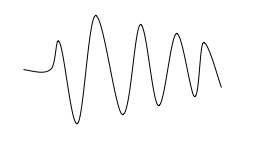
Figure 1.1
Correspondingly, Figure 2.1, 2.2 and 2.3 represent the forces on the hand as the ball strikes on, above and below the sweet spot. This is basically a graph of the handle vibrations. The vibrations produced when the ball strikes near the tip or throat of the racquet are not created when the ball hits the sweet spot. You may also note that the first portion of the signal in Figure 2.2, (the ball struck near the racquet tip) is positive (goes up) while the corresponding portion of the signal in Figure 2.3 (the ball struck near the throat) is negative (goes down). This is because the handle moves toward the incoming ball if it strikes near the tip and the handle moves away from the incoming ball if the ball strikes near the throat of the racquet.

Figure 2.1
The vibrations generated vary by the flexibility of the racquet, how hard the ball is hit and the location the ball strikes the racquet. Next month will continue this column and discuss the methods used to dampen racquet vibrations. Wishing you and your dear ones a happy and healthy holiday season ... Jani
This column is copyrighted by Jani Macari Pallis, Ph.D., all rights
reserved.
Dr. Jani Macari Pallis is the founder and CEO of Cislunar Aerospace,
Inc., an engineering and research firm in San Francisco. In addition
to her engineering practice, she has led two collaborations between
NASA and Cislunar, creating educational materials on the aerodynamics
of sports for pre-college students and educators. As the head of
NASA's "Aerodynamics in Sports" project, she has led a team of
researchers investigating the aerodynamics, physics and biomechanics
of tennis. The group has conducted high speed video data capture at
the US Open and research of ball/court interaction, footwork, serve
speeds, trajectories and ball aerodynamics. Pallis received a BS and
MS from the Georgia Institute of Technology, an MS in mechanical
engineering from the University of California, Berkeley and a Ph.D.
in mechanical and aeronautical engineering from the University of
California, Davis. She is a member of the Executive Committee of The
International Sports Engineering Association.
Questions and comments about these columns can be directed to Jani by
using this form.
|



October 2022 Tennis Anyone: Patterns in Doubles by John Mills. September 2022 Tennis Anyone: Short Court by John Mills. |
 You will join 13,000 other subscribers in receiving news of updates to the Tennis Server along with monthly tennis tips from tennis pro Tom Veneziano.
You will join 13,000 other subscribers in receiving news of updates to the Tennis Server along with monthly tennis tips from tennis pro Tom Veneziano. 